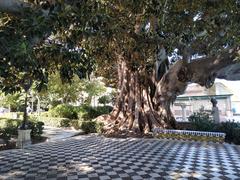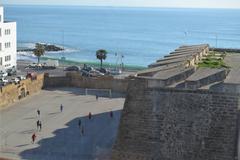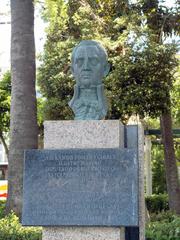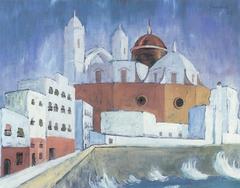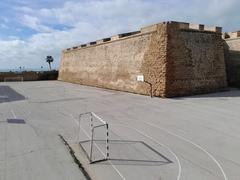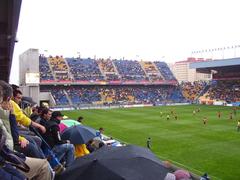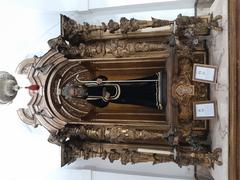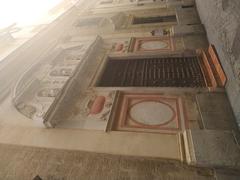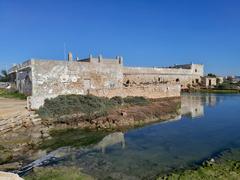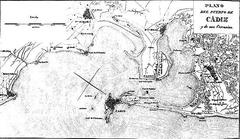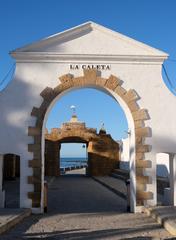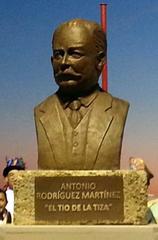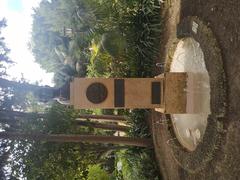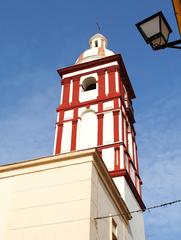Statue of Fernando Quiñones in Cádiz: Visiting Hours, Tickets, and Historical Significance
Date: 14/06/2025
Introduction
Set along the picturesque Paseo Fernando Quiñones in Cádiz, Spain, the Statue of Fernando Quiñones is a distinguished tribute to one of the region’s most influential literary figures and cultural advocates. Sculpted by Luis Quintero in 2004, this life-sized bronze monument captures the poet’s approachable demeanor and underscores his profound connection to Cádiz’s maritime culture. With its prime location near Playa de la Caleta and the historic Castillo de San Sebastián, the statue is a gateway to exploring Cádiz’s literary heritage, coastal beauty, and vibrant urban history.
Fernando Quiñones (1930–1998), born in nearby Chiclana de la Frontera, was known for evocative poetry, novels, and essays that bridged Spain, the Americas, and the Arab world. As an ardent advocate for flamenco and a founder of significant cultural institutions, Quiñones left a lasting impact on Cádiz’s cultural renaissance. The statue’s placement at the promenade reflects the spot where Quiñones famously declared his love for Cádiz, encapsulating his unique bond with the city.
This comprehensive guide provides essential information for visitors—covering practical details such as visiting hours, accessibility, travel tips, and nearby attractions—while exploring the artistic symbolism of the statue, related cultural events, and annual celebrations like the Ruta Fernando Quiñones walking tour. Whether you are a literature enthusiast, history buff, or traveler seeking to immerse yourself in Cádiz’s vibrant cultural scene, this guide will help you appreciate the lasting significance of the Fernando Quiñones statue and its surroundings.
For the latest schedules, event updates, and additional insights, consult official resources: the Cádiz Tourism Website, the Asociación Amigos de Fernando Quiñones, and cultural listings (academia-lab.com; es.wikipedia.org).
Contents
- Introduction
- Historical Background & Cultural Legacy
- Origins of the Statue and Its Location
- Fernando Quiñones: Life and Influence
- Civic Engagement and Cultural Advocacy
- Visiting the Fernando Quiñones Statue
- Location and How to Get There
- Visiting Hours and Accessibility
- Best Times to Visit
- Nearby Attractions
- Symbolism and Artistic Features
- Cultural Significance & Community Engagement
- Annual Events and Cultural Routes
- Ruta Fernando Quiñones
- Exhibitions and Installations
- Educational Programs
- Integration with Cádiz’s Cultural Calendar
- Visitor Information & Travel Tips
- What to Bring
- Safety and Etiquette
- Accessibility
- Amenities
- Weather
- Photography and Social Media
- Language & Communication
- Sustainability
- FAQ
- Conclusion
- Sources
Historical Background & Cultural Legacy
Origins of the Statue and Its Location
The statue occupies a prominent position on Paseo Fernando Quiñones, by the entrance to the walkway leading to Castillo de San Sebastián and adjacent to Playa de la Caleta. This is a site of personal and symbolic significance—where Quiñones once told his wife, “Nadia, quiero hacerte un regalo: te regalo Cádiz” (“Nadia, I want to make you a gift: I give you Cádiz”). In return, the city dedicated both the promenade and the statue to his legacy, entwining his memory with Cádiz’s maritime spirit (academia-lab.com; es.wikipedia.org).
Fernando Quiñones: Life and Influence
Born in Chiclana de la Frontera in 1930, Quiñones grew up in Cádiz, absorbing the city’s working-class culture and coastal inspiration. He began publishing in 1948, with early works appearing in El Parnaso and Platero. His prolific output includes poetry, novels, and essays such as Crónicas de mar y tierra (1968) and Las crónicas de Al-Andalus (1970), works that weave together cultural influences from Spain, the Americas, and the Arab world (biografiasyvidas.com). He was also a renowned flamenco scholar, authoring the influential De Cádiz y sus cantes (1964).
Civic Engagement and Cultural Advocacy
Quiñones’s impact extended beyond literature. He founded the Alcances festival in 1968, which brought multidisciplinary arts to Cádiz’s summers. He was instrumental in the creation of the Peña Flamenca Enrique el Mellizo, the city’s first flamenco club, and his advocacy for the arts played a key role in Cádiz’s cultural revival (es.wikipedia.org).
Visiting the Fernando Quiñones Statue
Location and How to Get There
- Address: Paseo Fernando Quiñones, Cádiz, Spain
- By Foot: A 15–20-minute walk from Cádiz’s city center along the scenic seafront.
- By Public Transport: Local buses stop near Playa de la Caleta (consult city bus schedules).
- By Car: Limited parking, especially in peak season; Parking Santa Catalina is the closest public facility.
Visiting Hours and Accessibility
- Hours: The statue is outdoors and accessible 24/7, year-round.
- Tickets/Admission: Free—no tickets or entry fees required.
- Accessibility: The promenade and statue area are wheelchair-accessible, with paved paths and ramps.
Best Times to Visit
- Early morning or late afternoon: Best for photography and a tranquil atmosphere.
- Sunset: Popular for dramatic views across the Atlantic.
- Festival periods: The promenade is liveliest during cultural events like Alcances.
Nearby Attractions
- Castillo de San Sebastián: A historic fortress reached by the promenade (andalucia.org).
- Playa de la Caleta: A beloved urban beach for swimming and sunsets.
- La Viña neighborhood: Known for tapas bars and flamenco.
- Castillo de Santa Catalina: Venue for cultural exhibitions and events.
Symbolism and Artistic Features
Sculpted by Luis Quintero, the statue depicts Quiñones standing barefoot, hands behind his back, gazing toward the ocean—a reflection of his contemplative nature and deep connection to Cádiz’s maritime soul. The choice of bronze ensures durability against the coastal climate, while details like his guayabera shirt and book in hand evoke both his approachable personality and literary contributions. The statue’s orientation toward the Atlantic symbolizes Cádiz’s role as a bridge between cultures (academia-lab.com).
Cultural Significance & Community Engagement
The Asociación Amigos de Fernando Quiñones keeps the writer’s memory alive through annual events, literary routes, and gatherings. The statue serves as a focal point for cultural celebrations and poetry readings, anchoring Quiñones’s legacy in Cádiz’s vibrant community.
Annual Events and Cultural Routes
The Ruta Fernando Quiñones
Each year, the Ruta Fernando Quiñones walking tour honors the writer’s legacy. Organized by the Asociación Amigos de Quiñones and the city council, this free event is held in the spring, starting at the statue and passing through key sites featured in Quiñones’s work. Guided by local artists and writers, the route includes readings, performances, and historical commentary (Diario de Cádiz).
Art Exhibitions and Installations
- “Fernando Quiñones: Un regalo para Cádiz” — Exhibition at Castillo de Santa Catalina, featuring artworks, unpublished manuscripts, and personal items. Open daily 11:00–19:00, free admission (Cadiz.es).
- “Las mil noches de Fernando Quiñones” — A rotating exhibition commemorating Quiñones’s life and impact, with panels, testimonies, and audiovisual materials (Junta de Andalucía).
Literary and Educational Programs
Year-round, the Asociación Amigos de Quiñones organizes contests, workshops, and educational activities, often in collaboration with the University of Cádiz and the Centro Andaluz de las Letras. Events are scheduled around Quiñones’s birthday (March 2) and anniversary of his passing (November 17).
Integration with Cádiz’s Cultural Calendar
Quiñones-related events are woven into Cádiz’s broader cultural scene, including:
- Carnival of Cádiz (Feb–Mar)
- Alcances Atlantic Film Festival (Sep–Oct)
- Cadiz en Danza Festival (Jun) (Spain.info)
Visitor Information & Travel Tips
What to Bring
- Camera/smartphone for photos.
- Comfortable footwear for walking the 650m promenade.
- Sun protection: hat, sunglasses, sunscreen.
- Water and snacks.
Safety and Etiquette
The area is safe, with regular police presence. Remain vigilant with personal belongings, especially during events. Climbing on the statue is prohibited; visitors are encouraged to read the plaque and reflect respectfully.
Accessibility
The promenade and statue are accessible for wheelchairs and strollers. Benches and accessible restrooms are available at La Caleta Beach.
Amenities
- Food & Drink: Beachside chiringuitos and tapas bars in La Viña. Recommended: Freiduria Marisquería Las Flores 1.
- Restrooms: Available at La Caleta Beach and within the castles during opening hours.
Weather
Cádiz enjoys a mild Mediterranean climate with over 300 days of sun. Summer highs average 27–30°C (80–86°F); winters are mild. Check the local weather forecast before visiting.
Photography & Social Media
The statue is especially photogenic at sunrise and sunset. Use hashtags #FernandoQuiñones and #Cádiz. Drone photography is allowed but must comply with Spanish aviation regulations.
Language & Communication
Spanish is the main language; English is widely understood in tourist areas. Plaques at the statue are in Spanish; translation apps can assist as needed.
Sustainability
Dispose of litter properly, minimize noise, and support local businesses. Guided tours with local experts foster sustainable tourism (cadizturismo.com).
Frequently Asked Questions (FAQ)
What are the visiting hours of the Statue of Fernando Quiñones?
The statue is outdoors and accessible 24 hours a day, year-round.
Is there an entrance fee or ticket required?
No, the statue is free to visit.
Are guided tours available?
Yes, local operators and the Asociación Amigos de Quiñones offer tours, particularly during cultural events.
Is the site accessible to people with disabilities?
Yes, the area features ramps and smooth pathways.
Can I take photos?
Yes, photography is encouraged.
Are there events at the statue?
Yes, especially during the Ruta Fernando Quiñones and on commemorative dates.
Conclusion
The Statue of Fernando Quiñones in Cádiz offers a unique convergence of art, literature, and local identity. Open at all hours and freely accessible, it stands as a living tribute to a writer whose work and advocacy continue to shape Cádiz’s cultural landscape. Enrich your visit by exploring nearby attractions, participating in annual events, and delving deeper into Quiñones’s legacy through exhibitions and guided tours.
Plan your visit using official resources, and consider downloading the Audiala app for audio guides and event updates. Experience Cádiz through the words, spirit, and enduring influence of Fernando Quiñones.
Visuals
All images include descriptive alt tags for accessibility.
Sources & Official Links
- Visiting the Fernando Quiñones Statue in Cádiz: History, Hours, and Travel Tips, 2025, Academia Lab
- Fernando Quiñones Statue in Cádiz: Visiting Hours, Tickets, and Cultural Significance, 2025, Cádiz Cultura
- Visiting the Statue of Fernando Quiñones in Cádiz: Hours, Access, and Nearby Attractions, 2025, Andalucía Tourism
- Exploring Fernando Quiñones: Visiting Hours, Tickets, and Cultural Routes in Cádiz, 2025, Diario de Cádiz & Cádiz.es
- Official Cádiz Tourism Website, 2025
- Asociación Amigos de Fernando Quiñones Blogspot, 2025
- Diario de Cádiz, 2025, Cultural Events Coverage
- Andalucía Cultural Guide, 2025
